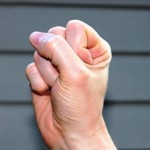By SANDY ANDREWS
Certified Hand Therapist
A common statement I hear as a hand therapist is: “Something is wrong with my finger. When I wake up in the morning it is locked in a bent position and I can’t straighten it.”
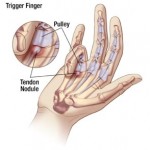 This tell-tale testimony of a locking finger is commonly known as trigger finger. The medical term for this condition is tenosynovitis or inflammation of the tendon sheath. This condition sometimes requires surgery, but can also be treated conservatively through exercises and therapy.
This tell-tale testimony of a locking finger is commonly known as trigger finger. The medical term for this condition is tenosynovitis or inflammation of the tendon sheath. This condition sometimes requires surgery, but can also be treated conservatively through exercises and therapy.
Symptoms associated with trigger finger include a tender bump under the palm crease at the base of the finger, swelling and stiffness and pain in the middle joint of the finger.
Instead of a smooth gliding finger, the digit will hesitate, click or snap during bending or straightening.
What causes trigger finger?
The exact cause of trigger finger is unknown, but it is generally seen more in women and those working in jobs requiring repetitive gripping. Sometimes, underlying illnesses that cause inflammation such as arthritis, gout, diabetes and auto-immune disease, can cause trigger finger.
Once the tendon sheath has become inflamed or thickened, it has difficulty gliding through the pulley system of the finger. The pulleys are a group of tunnels which hold the tendons close to the bone.
A normal tendon will glide through the pulley system without resistance. However, when the tendon is swollen, popping and catching occurs making gliding difficult. Each time the tendon gets stuck and then suddenly releases, it produces more swelling and damage to the tendon.
Conservative trigger finger treatment
Trigger finger can be treated conservatively if the condition has been present for fewer than 6 months and the finger has normal range of motion and minor triggering. The following steps are recommended for healing the inflamed tendon.
- Schedule an appointment with YOA’s hand surgeon, Dr. Les Schwendeman, to confirm the diagnosis and get instructions for conservative management options.
- Start the conservative hand therapy program prior to your appointment.
- Begin the following steps to unlock a triggered finger.
- When your finger locks in a bent position, follow the three steps (locked, hook and straight) to unlock your finger without popping or pain to avoid further damage to your tendon.
(triggered)
b. Hook position
(unlocking)
(unlocked)
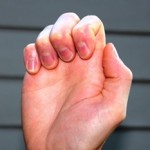
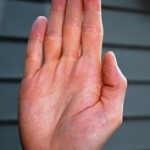 Complete 20 repetitions of hook fist to straight finger exercise every hour during the daytime for eight hours in a row. This exercise stimulates the production of synovial fluid, a healing lubricant responsible for providing nutrition and lubrication to the tendon. This will decrease inflammation of the injured tendon.
Complete 20 repetitions of hook fist to straight finger exercise every hour during the daytime for eight hours in a row. This exercise stimulates the production of synovial fluid, a healing lubricant responsible for providing nutrition and lubrication to the tendon. This will decrease inflammation of the injured tendon.
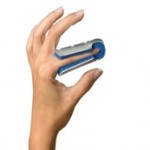 Purchase a finger extension (straightening) splint from your local drug store and wear it while you sleep to avoid a locked finger in the morning.
Purchase a finger extension (straightening) splint from your local drug store and wear it while you sleep to avoid a locked finger in the morning.
- Apply an ice cube to the skin, in a circular motion, directly over the bump/nodule on your palm for two minutes, three times a day. Wrap a napkin around the area of the ice cube you will be holding to keep it from slipping out of your hand.
- Avoid activities that cause your finger to trigger. This typically includes activities that require repetitive and or resistive gripping tasks. Also, avoid testing your finger to see if it triggers. Remember that every time you cause your finger to trigger you are increasing the destruction of the tendon. If you do cause your finger to trigger, follow the above unlocking instructions.
When is surgery an option?
If conservative measures fail, surgery can correct the finger. The surgeon will cut the A1 pulley in half to stop the triggering, allowing the tendon to heal and glide without resistance.
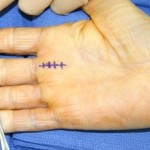 The outpatient procedure takes about 20 minutes. Your follow-up appointment with Dr. Schwendeman and initial visit with a hand therapist will occur between 7-14 days after surgery.
The outpatient procedure takes about 20 minutes. Your follow-up appointment with Dr. Schwendeman and initial visit with a hand therapist will occur between 7-14 days after surgery.
Dr. Schwendeman will prescribe six sessions of therapy, once a week for six weeks, which will focus on scar and edema reduction massage, range of motion, modalities to increase tendon health and progressive strengthening.
Each patient will receive a personalized treatment program based upon the severity of symptoms and the level of tendon destruction. Returning to work will depend upon the patient’s job tasks. Those working in desk jobs may need two to three days off. Those working in manual labor positions may need up to four weeks off.

